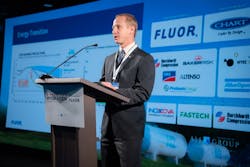By Patrick Goodman
Technical Director; Fellow, Clean Hydrogen Technologies. Fluor Corporation
It has been five years since the International Energy Agency released the report titled, “The Future of Hydrogen.” This sparked a flurry of activity worldwide with the 2020s quickly being dubbed the “Decade of Hydrogen,” and the past few years seeing exciting new project announcements across the full range of the hydrogen color spectrum. However, very few have progressed to Final Investment Decision (FID). With 2030 as the first major signpost on the energy transition roadmap, it is becoming clear that industry is not on track to meet the decarbonization goals initially laid out by governments around the world. This begs the question, is the hydrogen future all hype, or something more?
This Time is Different
The idea of a hydrogen economy goes back to the 1970s with multiple boom and bust cycles since. This raises the question: Is this just another hype cycle? Aside from government policy and social considerations, a key difference this time is the rapid expansion of low-cost renewable energy sources.
The peak of expectations perhaps can be tied to the passage of the 45V hydrogen production tax credits in 2022, part of the United States government’s Inflation Reduction Act, that aims to support clean energy initiatives within the country. It is designed to encourage the production of clean hydrogen generated with low greenhouse gas emissions.
This low carbon hydrogen should be part of the solution, particularly in hard-to-decarbonize sectors. According to the recent Harnessing Hydrogen report prepared by the National Petroleum Council, achieving net zero emissions in the United States without low-carbon hydrogen will cost hundreds of billions more on an annual basis compared to net zero with low-carbon hydrogen.
Overcoming Industry Challenges
Every major industrial project faces challenges, and hydrogen is no exception. Low- carbon hydrogen projects face challenges around policy uncertainty, stubbornly high capital costs, financing hurdles, technology maturity, limited infrastructure and a lack of harmonized or fully developed codes and standards.
Many of these challenges can and will be addressed as the first wave of projects is deployed. Capital costs will fall as the industry scales and plants become more repeatable. Financing will become more routine as the number of uncertainties and risk surrounding these projects falls. Additionally, the deployment of these projects will grow the pool of skilled workers and begin to develop a more mature and interconnected hydrogen ecosystem.
However, the industry needs policy and regulatory certainty to begin this process. As proposed, the 45V regulations do ensure low-carbon hydrogen is truly clean - providing important credibility to the industry. The regulations are strict, but the incentives are substantial. At this point, the 45V tax credit and associated regulatory framework is yet to be finalized. The public comment period netted nearly 30,000 comments from the public and industry experts and some lawmakers are seeking to add flexibility to 45V. Therefore, until the 45V tax credit and proposed regulations are finalized, the market continues to seek certainty, sidelining some key projects.
Embracing The Positives
While challenges abound, there are positive indicators in the market. The delay in widespread project implementation has allowed electrolyzer manufacturers to ramp up capacity. Electrolyzers, devices that use electricity to split water into hydrogen and oxygen, are key to creating green hydrogen. The limited supply of electrolyzers was a major concern two years ago but today equipment manufacturers have significantly stepped up, alleviating this concern and demonstrating their belief in the growth of the market.
Another small but growing bright spot is low-carbon hydrogen demand. The focus has largely been on the hydrogen supply side, but key to a fully functioning clean hydrogen economy is stimulating demand and providing a cost-effective means to connect the supply to the demand. Early offtake agreements center on decarbonizing traditional hydrogen users in the refining, chemicals and fertilizer space. Notably, growth areas like green steel are also gaining traction in the market.
While dealing with hydrogen is not new, the scope and scale that we are now considering is much broader than ever before. Uncertainty around policy details remains a major challenge, but progress is being made worldwide with important steps in the United States, Europe and beyond. Traditional sectors will lead the way in low-carbon hydrogen and provide an avenue for deployment in new applications. Unlike previous hydrogen booms, this one is on a path to move beyond the hype with a strong growth trajectory and substantial projects expected for the foreseeable future.
As the industry overcomes initial hurdles and begins to scale, hydrogen stands to play one of the most pivotal roles in the global energy market, offering a pathway to a cleaner, more sustainable energy future. The Decade of Hydrogen is just the beginning.
Fluor Feature Project – First-of-a-Kind Hydrogen Home, Powering Communities of the Future
Fluor partnered with SoCalGas, the largest natural gas distribution utility in the U.S., to provide engineering, procurement and construction management (EPCM) services to design and build what is considered to be North America’s first-ever clean, renewable hydrogen powered microgrid and home.
This project, located near Los Angeles, demonstrates how net-zero gas made from renewable electricity can be used in pure form or as a blend to fuel energy systems and communities of the future.
The project was finished in late 2022 and was named a World-Changing Idea by Fast Company and awarded the U.S. Green Building Council of L.A.'s Sustainable Innovation Award. It features a clean, renewable hydrogen production and storage along with a nearly 2,000 square-foot home that can draw power from solar panels and convert excess renewable energy into clean renewable hydrogen.
Fluor’s Hydrogen Capabilities
A versatile gas with no carbon emissions, hydrogen is a clean alternative to fossil fuels. Fluor is accelerating its adoption by working with clients to determine the most economically viable technology and execution solutions for hydrogen production, storage and transportation.
Fluor, with nearly 34,000 employees, delivers energy transition projects around the world and has extensive experience working with all hydrogen types, including green hydrogen from renewably powered electrolysis or biomass gasification and blue hydrogen using carbon capture.


